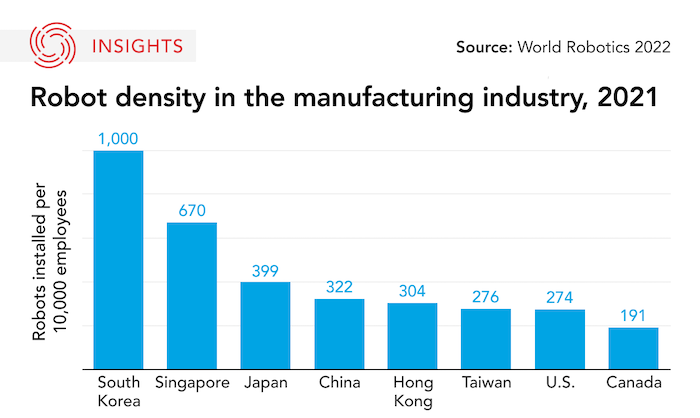The Takeaway
South Korea’s government and numerous industries have been dramatically increasing the use of robots to solve issues related to the country’s declining working-age population and changes in societal labour preferences. This trend has also raised uncomfortable questions about job loss, immigration, ethics, and regional development.
In Brief
According to the World Robotics 2022 report by the International Federation of Robotics released in January 2023, South Korea ranked first in the world for robot density, with 1,000 industrial robots per 10,000 manufacturing employees in 2021. South Korea's robot density, or the number of robots per 10,000 employees, is seven times higher than the global average, which stands at 141 robots per 10,000 employees. The country’s remarkable use of robots has intensified the debate on whether automation will eventually encroach on, or increase, human jobs.

South Korea’s population has declined over the past three years due to its low fertility rate (the world’s lowest), in the process reducing the working-age population and turning the country into a so-called ‘Aging Society.’ As a result, since 2019, the government has actively introduced automation, such as robots and artificial intelligence (AI), into various industrial sites to boost economic development. Robot- and AI-led automation is becoming an alternative for South Korea's future economy and society. It also allows the government to avoid politically sensitive national discussions on expanded immigration policies and programs. The COVID-19 pandemic may have accelerated the trend of automation, which could morph into a solution for South Korea’s changing demography and its conservative immigration policy.
The use of robots in South Korea’s manufacturing and service sectors is also accelerating as more people avoid difficult, dirty, and dangerous jobs – so-called ‘3D jobs.’ With this decline in South Korea’s labour force, the manufacturing sector increasingly relies on foreign trainees or foreign seasonal workers.
However, it appears that South Korean companies, mainly in the manufacturing and service sectors, are beginning to prefer robots that can work 24/7, do not get sick or complain, and can help them balance against strong unions they think have been hurting their businesses. Companies regard a reduction in labour costs and increased productivity as significant advantages of automation, arguing that they do not have to guarantee adequate labour rights with benefits to robots.
Implications
According to a December 2021 article by the Korea Institute for Economic Research, the overall job loss rate due to the increase in robots is not statistically significant in South Korea. Yet the article found that introducing robots reduces jobs in manufacturing industries and unskilled or semiskilled service work in South Korea.
Meanwhile, a 2021 Bank of Korea report showed that an increase of one industrial robot per 1,000 workers in South Korea would reduce the number of workers by 0.1 percentage points and real wage growth by 0.3 percentage points. However, it’s not all gloom and doom. The Korea Institute of Public Finance argued in 2022 that automation had increased jobs in some South Korean regions and that if robots and AI help increase profitability, then both business and recruitment will grow.
South Korea topping the charts of robot density means that the country will be a real-life litmus test for putting these discussions into practice. The above research suggests that to avoid negative consequences related to job loss, robots should be used to find and solve new tasks for people, and government and businesses should introduce re-training courses for workers who are more vulnerable to robot “infiltration.”
What's Next
- More South Korean conglomerates in robotics
Samsung, Hyundai, and LG are rushing to enter the robot industry. Samsung applied for a patent for its robot brand "SAMSUNG BOT" in the U.S. and Canada in 2022, and made a C$64-million (59 billion-won) investment in Rainbow Robotics in January as the first large-scale robotics investment of 2023.
- Ethical guidelines for use of robots and AI
There are growing ethical and legal concerns about using robots and AI for crimes and deceiving or harassing users and consumers. In South Korea, the use of AI care robots for senior citizens living alone has triggered a discussion in academia on how the traditional value of filial piety should be applied to robots. Some military experts foresee that completely autonomous combat robots may emerge in military conflicts around the world. South Korean experts could lead in establishing a code of ethics in the development and use of robots and AI.
- Growing digital gap between generations and regions
Dramatic increases in the use of automated devices such as robots and AI in the service industry to find information, place orders, and the like could trigger unease in some segments of society. The Korea Consumer Agency recommended standardizing functions and designs of automation such as kiosk robots and screens in the service sector in consideration of people with disabilities and senior citizens. Similarly, areas with slow development and use of robots and AI will inevitably lag behind regional security and economic development. This may increase the socio-economic gap between generations or regions.
• Produced by CAST’s Northeast Asia team: Dr. Scott Harrison (Senior Program Manager); Momo Sakudo; (Analyst); and Tae Yeon Eom (Analyst).
